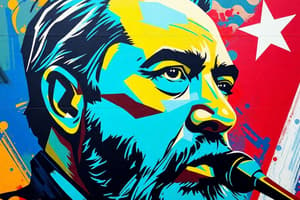Podcast
Questions and Answers
Considering the geopolitical strategies of the 18th century, what was the most critical long-term implication of the 1763 Treaty of Paris regarding Havana's exchange for Florida?
Considering the geopolitical strategies of the 18th century, what was the most critical long-term implication of the 1763 Treaty of Paris regarding Havana's exchange for Florida?
- It highlighted the strategic importance of controlling key ports for naval power projection and trade dominance. (correct)
- It demonstrated Spain's willingness to concede territory to maintain control over valuable sugar-producing colonies.
- It established a precedent for resolving territorial disputes through negotiated exchange, minimizing future conflicts.
- It solidified British dominance in the Caribbean, paving the way for future acquisitions.
How did the legacy of José Martí's ideology most profoundly influence the nature of Cuban nationalism in the 20th century?
How did the legacy of José Martí's ideology most profoundly influence the nature of Cuban nationalism in the 20th century?
- By advocating for complete economic isolation from foreign influence to maintain sovereignty.
- By fostering a strategic alliance with powerful nations to counterbalance imperialist threats.
- By promoting a gradualist approach to political reform that prioritized negotiation over armed conflict.
- By establishing a tradition of revolutionary martyrdom that inspired subsequent uprisings and resistance movements. (correct)
What latent function did the Platt Amendment serve within the framework of early 20th-century U.S. foreign policy objectives in the Caribbean?
What latent function did the Platt Amendment serve within the framework of early 20th-century U.S. foreign policy objectives in the Caribbean?
- It promoted economic diversification, thereby diminishing Cuba's reliance on sugar exports and promoting self-sufficiency.
- It facilitated the implementation of progressive social reforms, aimed at modernizing Cuban society and reducing social inequality.
- It encouraged the development of democratic institutions, fostering political stability and minimizing the risk of future unrest.
- It cultivated a façade of Cuban sovereignty, permitting the U.S. to exercise hegemonic control without overt annexation. (correct)
In what way did Batista's ascent to power exemplify the destabilizing effects of neocolonialism on Cuban political institutions?
In what way did Batista's ascent to power exemplify the destabilizing effects of neocolonialism on Cuban political institutions?
How did the failure of Castro's initial attack in 1953 paradoxically contribute to the eventual success of the Cuban Revolution?
How did the failure of Castro's initial attack in 1953 paradoxically contribute to the eventual success of the Cuban Revolution?
What specific socio-economic policies implemented by Castro after 1959 most directly contradicted his initial promises of democracy and political pluralism?
What specific socio-economic policies implemented by Castro after 1959 most directly contradicted his initial promises of democracy and political pluralism?
How did Cuba's alignment with the Soviet Union in 1960 fundamentally alter the dynamics of the Cold War in the Western Hemisphere?
How did Cuba's alignment with the Soviet Union in 1960 fundamentally alter the dynamics of the Cold War in the Western Hemisphere?
What critical strategic miscalculation during the Bay of Pigs invasion led to its swift and decisive failure?
What critical strategic miscalculation during the Bay of Pigs invasion led to its swift and decisive failure?
To what extent did Spanish colonial policies inadvertently foster a sense of national identity among Cubans before the 19th century?
To what extent did Spanish colonial policies inadvertently foster a sense of national identity among Cubans before the 19th century?
How did the institution of slavery uniquely shape Cuban cultural expressions compared to other Caribbean islands?
How did the institution of slavery uniquely shape Cuban cultural expressions compared to other Caribbean islands?
What enduring paradox characterizes the legacy of Fidel Castro in Cuban historiography?
What enduring paradox characterizes the legacy of Fidel Castro in Cuban historiography?
How did the United States' ambivalent approach to Cuban independence in the early 20th century establish a precedent for future interventions in Latin America?
How did the United States' ambivalent approach to Cuban independence in the early 20th century establish a precedent for future interventions in Latin America?
What role did the transatlantic slave trade play in shaping Cuba's economic dependence on sugar production during the colonial era?
What role did the transatlantic slave trade play in shaping Cuba's economic dependence on sugar production during the colonial era?
What are some of the critical differences between interpretations of the explosion of the USS Maine as understood by historians from the United States versus those from Cuba?
What are some of the critical differences between interpretations of the explosion of the USS Maine as understood by historians from the United States versus those from Cuba?
In what ways did the guerrilla tactics employed by Cuban revolutionaries under Castro influence subsequent revolutionary movements in Latin America and beyond?
In what ways did the guerrilla tactics employed by Cuban revolutionaries under Castro influence subsequent revolutionary movements in Latin America and beyond?
What were the unintended consequences of the U.S. embargo on Cuba following the Cuban Revolution?
What were the unintended consequences of the U.S. embargo on Cuba following the Cuban Revolution?
To what extent did Cold War tensions between the United States and the Soviet Union exacerbate internal conflicts within Cuban society during the 1960s?
To what extent did Cold War tensions between the United States and the Soviet Union exacerbate internal conflicts within Cuban society during the 1960s?
How did Spain's focus on extraction of resources from Cuba undermine the long term economic development of the island?
How did Spain's focus on extraction of resources from Cuba undermine the long term economic development of the island?
What influence did the Santeria religion have in shaping the cultural identity and resistance against colonial oppression?
What influence did the Santeria religion have in shaping the cultural identity and resistance against colonial oppression?
What were the long-term strategic goals of the Soviet Union's decision to place nuclear missiles in Cuba in 1962?
What were the long-term strategic goals of the Soviet Union's decision to place nuclear missiles in Cuba in 1962?
Flashcards
Christopher Columbus (1492)
Christopher Columbus (1492)
Italian sailor who sailed for Spain, aiming to find a faster route to India but landed in Cuba, mistakenly believing it was Asia.
Diego de Velázquez
Diego de Velázquez
Spanish conquistador who colonized Cuba, establishing it as a Spanish colony and leading to the growth of Havana.
Slavery in Cuba (1526)
Slavery in Cuba (1526)
The forced transportation of people from West Africa to Cuba by the Spanish to work due to the decline of the native Taíno population.
British Capture of Havana (1762)
British Capture of Havana (1762)
Signup and view all the flashcards
Carlos Manuel de Céspedes
Carlos Manuel de Céspedes
Signup and view all the flashcards
End of Slavery in Cuba (1886)
End of Slavery in Cuba (1886)
Signup and view all the flashcards
José Martí
José Martí
Signup and view all the flashcards
Spanish-American War (1898)
Spanish-American War (1898)
Signup and view all the flashcards
Platt Amendment
Platt Amendment
Signup and view all the flashcards
Fulgencio Batista
Fulgencio Batista
Signup and view all the flashcards
Castro's First Attack (1953)
Castro's First Attack (1953)
Signup and view all the flashcards
Granma Landing (1956)
Granma Landing (1956)
Signup and view all the flashcards
Cuban Revolution Success (1959)
Cuban Revolution Success (1959)
Signup and view all the flashcards
Castro's Communism (1960)
Castro's Communism (1960)
Signup and view all the flashcards
Bay of Pigs Invasion (1961)
Bay of Pigs Invasion (1961)
Signup and view all the flashcards
Study Notes
- Aimed at Talis, these notes detail Cuba’s history from 1492 to 1961, focusing on the selfish ambitions of Spain, Britain, and the U.S., and how Fidel Castro became a dictator despite initial good intentions.
1492 – Columbus Arrives in Cuba
- Christopher Columbus, working for Spain’s King Ferdinand and Queen Isabella, landed in Cuba in 1492.
- Columbus believed he had reached China or Japan when he arrived in Cuba.
- His goal was to discover a faster route to India for gold, silk, and spice trade.
- Columbus sailed with three ships: the Niña, Pinta, and Santa María.
- Spain claimed Cuba, marking the beginning of the age of conquest.
1511 – Spanish Colonization
- Diego de Velázquez de Cuéllar led the Spanish colonization of Cuba.
- Spain sought gold, sugar, and land, needing a Caribbean base.
- Velázquez and his forces killed or enslaved the native Taíno population.
- Cuba became a Spanish colony, and Havana grew into a major city.
1526 – Beginning of Slavery
- The Spanish began importing enslaved people from West Africa (Angola, Congo, and Ghana).
- The Taíno population was decimated by disease and Spanish cruelty, necessitating new laborers.
- Enslaved people were transported across the Atlantic in horrific conditions.
- African traditions significantly influenced Cuban culture, including salsa, rumba, and Santería.
1762 – British Capture of Havana
- The British navy, under Admiral George Pocock and Lord Albemarle, captured Havana.
- Britain aimed to control Cuban sugar and weaken Spain.
- The British bombarded Havana for two months, leading to Spain’s surrender.
- Spain regained Havana in 1763 through the Treaty of Paris, ceding Florida to Britain.
1868-1878 – Ten Years’ War
- Carlos Manuel de Céspedes, a Cuban landowner, initiated the rebellion by freeing his slaves.
- Cubans sought freedom from Spain and equal rights.
- They employed guerrilla warfare in the mountains but faced supply shortages.
- Spain promised reforms but did not deliver, maintaining control.
1886 – Abolition of Slavery
- International pressure and Cuban resistance led to the abolition of slavery in Cuba.
- Former enslaved people transitioned into roles as farmers, musicians, and soldiers.
1895-1898 – Second War of Independence
- José Martí, Cuba’s key revolutionary figure, spearheaded the fight for independence.
- Spain continued to deny Cuba independence.
- Martí died in battle, but his vision of a free Cuba lived on.
1898 – Spanish-American War
- The U.S. used the explosion of the USS Maine as justification to invade Cuba.
- Spain lost the war in four months, and Cuba was handed over to the U.S.
- The U.S. maintained control over Cuba, rather than granting full independence.
1902 – Nominal Independence
- The Platt Amendment allowed the U.S. to intervene in Cuban affairs.
- Cuba was not genuinely independent due to U.S. intervention.
1933 – Batista's Rise to Power
- Fulgencio Batista, initially a soldier, seized control through a coup and became a dictator.
- Cuba became corrupt and heavily influenced by the mafia under his rule.
1953 – Failed Attack by Castro
- Fidel Castro attempted to overthrow Batista but was captured and exiled.
- He fled to Mexico to plan his return to Cuba.
1956 – Castro, Guevara, and Guerrilla Warfare
- Fidel Castro, Che Guevara, and 82 rebels landed in Cuba on El Yate Granma.
- They engaged in guerrilla warfare in the mountains for two years.
1959 – Cuban Revolution Success
- Batista fled as Castro’s forces entered Havana.
- Castro assumed power, initially promising democracy.
1960 – Castro's Shift to Communism
- Castro seized American businesses, causing the U.S. to sever ties.
- Cuba allied with the Soviet Union.
1961 – Bay of Pigs Invasion Failure
- Cuban exiles, trained by the CIA, launched an invasion.
- They landed in Cuba but were defeated within three days.
- Castro’s power increased as a result of the failed invasion.
Studying That Suits You
Use AI to generate personalized quizzes and flashcards to suit your learning preferences.





